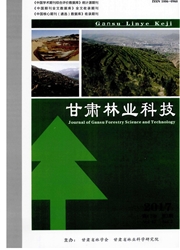

 中文摘要:
中文摘要:
在干旱区山地降雪是土壤和河流水分的重要补给源,也是土壤—植被—大气连续体中水文过程的一个重要环节。选择黑河上游的天涝池小流域为研究区,利用2013年春季一次降雪事件,对积雪厚度、积雪密度,青海云杉积雪载荷量和降雪对青海云杉幼芽的冻伤进行了调查分析,结果显示:本次降雪量为16 mm,雪密度为1.52 g/cm^3,本次降雪青海云杉积雪载荷量为1.61~4.62,幼芽的冻伤率高达60%以上。由此可知,青海云杉的截留能力较强,在大的降雪事件中可能会造成雪折,如果春节降雪发生的时间迟,对幼芽将造成严重冻害,由此抑制树木的生长。
 英文摘要:
英文摘要:
Snow is the one form for supplying water to soil and runoff in Qilian Mountains. It is also an important variable to simulate water flexure in soil-vegetation-atmosphere system. The study selected Tianlaochi catchments in the upper reaches of Heihe River in Qilian Mountains as a study area. We measured snow depth, snow density, and snow interception by Picea crassifolia and cold damage of Picea crassifolia sprouts in one snow event in May, 2013.The results showed that snow depth is 16 mm, snow density ranges from 0.148 to 0.155 g/cm^3, the ratio of snow intercepted amount by Picea crassifolia to the weight of branches ranged from 1.61 to 4.62 in the snow event, the capacity of snow interception by Qinghai spruce increase with the increase of leaf biomass loaded by branches, there is more60% sprouts frozen to death in the snow event. From the study, we can draw some conclusion that spring snow may be benefit to Qinghai spruce for supplying its water requirement. But it maybe causes the snow damage to the forests because of its large snow interception capacity. If the snow appears late in the spring, sprouts of Qinghai spruce will suffer from cold damage which will affect the growth of the species.
 同期刊论文项目
同期刊论文项目
 同项目期刊论文
同项目期刊论文
 Estimating realized and potential carbon storage benefits from reforestation and afforestation under
Estimating realized and potential carbon storage benefits from reforestation and afforestation under Physiological responses of Populus euphratica Oliv. to groundwater table variations in the lower rea
Physiological responses of Populus euphratica Oliv. to groundwater table variations in the lower rea The canopy rainfall interception in actual and potential distribution of Qinghai spruce (Picea crass
The canopy rainfall interception in actual and potential distribution of Qinghai spruce (Picea crass Evaluation of water use of Caragana korshinskii and Hippophae rhamnoides in the Chinese Loess Platea
Evaluation of water use of Caragana korshinskii and Hippophae rhamnoides in the Chinese Loess Platea Restoration and conservation potential of destroyed Qinghai spruce (Picea crassifolia) forests in th
Restoration and conservation potential of destroyed Qinghai spruce (Picea crassifolia) forests in th Characteristics of Caragana korshinskii and Hippophae rhamnoides stemflow and its significance in so
Characteristics of Caragana korshinskii and Hippophae rhamnoides stemflow and its significance in so Soil CO2 efflux along an elevation gradient in Qinghai spruce forests in the upper reaches of the He
Soil CO2 efflux along an elevation gradient in Qinghai spruce forests in the upper reaches of the He Soil water content and water balance simulation of Caragana korshinskii Kom. in the semiarid Chinese
Soil water content and water balance simulation of Caragana korshinskii Kom. in the semiarid Chinese SPECIES DISTRIBUTION MODELS TO ESTIMATE THE DEFORESTED AREA OF PICEA CRASSIFOLIA IN ARID REGION RECE
SPECIES DISTRIBUTION MODELS TO ESTIMATE THE DEFORESTED AREA OF PICEA CRASSIFOLIA IN ARID REGION RECE 期刊信息
期刊信息
